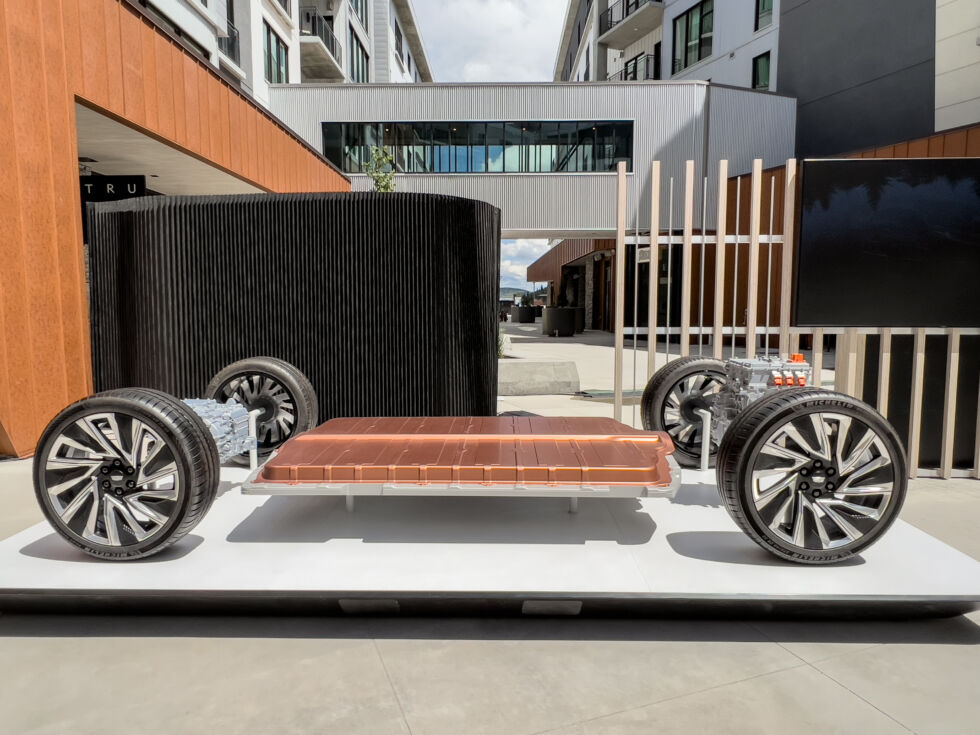
Jonathan Gitlin
PARK CITY, UTAH – They say – accurately in my opinion – that nothing sharpens the mind like a deadline. I’m not sure what the boost is when that deadline suddenly shrinks by nine months, as it did for Cadillac’s new Lyriq, but the result is an extremely competent new battery-electric SUV.
As we’ve discussed in the past, General Motors is at the beginning of an electrification plan that it hopes will eliminate tailpipe emissions from the group’s vehicles by 2035. The key to that is a family of batteries and electric motors (called Ultium) to be used in everything from large body-on-frame trucks to small crossovers. We’ve already tested a few early Ultium-based BEVs: the bombastic Hummer EV truck and BrightDrop Zevo 600 van. Both are rather niche applications, but the Lyriq is much more mainstream, given America’s love of the SUV.
At launch, the Lyriq will be available in a single-engine, rear-wheel drive configuration, with a twin-engine, four-wheel drive version in early 2023. The RWD Lyriq uses a 340 hp (255 kW), 325 lb-ft (440 Nm) version of the Ultium Drive motor, which is powered by a 102 kWh lithium-ion battery.

GM designed Ultium batteries to be highly modular, with each module having its own battery management system (which communicates wirelessly with the car). In the case of the Lyriq, it uses 12 modules (and a total of 288 cells) compared to the Hummer EV’s massive package of 24 modules. But the Lyriq is lighter, less powerful and more aerodynamic than that big truck, so it can achieve an EPA range of 502 km. (For more details on the Lyriq’s powertrain, enjoy our interview with GM’s head of EV powertrains from a few years ago.)
Not that the Lyriq is exactly small: At 196.7 inches (4,996 mm) long and 86.9 inches (2,207 mm) wide (with its mirrors), it’s the right size for American roads. However, Cadillac’s designers and engineers did a pretty good job of packing the batteries without making the SUV look unnaturally tall, at 63.9 inches (1623 mm). The wheelbase of 121.8 inches (3,094 mm) translates into plenty of interior volume for the front and rear occupants. But it’s certainly not a featherweight, weighing in at 5,610 lbs (2,545 kg).
I try not to waste too much time discussing what a car looks like, given how subjective that usually is. But I think Cadillac’s designers have done a fine job here, with some interesting touches like the Lyric’s front light panels and the treatment around the tailgate, which one colleague says harks back to the hustle and bustle of the Cadillac Seville. We don’t have a drag coefficient for the Lyriq yet, but it’s clear that aerodynamics was a design priority, with front air fins and low drag treatments for the SUV’s alloy wheels.

Jonathan Gitlin
The interior is equally impressive, especially for those of us who remember how bland GM interiors were. The flashiest feature is the 33-inch display that curves around the driver. Unlike other large infotainment screens we’ve seen recently, this is a single screen, not multiple panels glued under glass, Cadillac told us.
It’s similar to the three screen system in the Cadillac Escalade, with three zones: a small touch-sensitive multifunction area to the left of the driver, the main driver cluster (which can be configured to display a gauge, a map, or even very minimal information (speed, battery status) if you don’t want distractions. The right side of the screen is touch-sensitive, but can also be operated with the rotary knob on the center console.
The infotainment runs on the Android Automotive operating system, although the user interface will be relatively familiar if you’ve used a recent version of Cadillac’s infotainment in other vehicles. Wireless Android Auto and Apple CarPlay are both supported, and this is the first implementation of either I’ve used that can project directions from your phone to the map in front of the driver, rather than just showing up in Android Auto or CarPlay window on the infotainment side of the screen. Being powered by Android Automotive means you get great voice recognition too.

